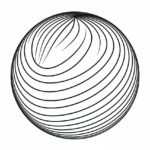Waves are a beautiful and dynamic subject to draw. Capturing their motion and energy can be challenging, but with the right technique and practice, you can create stunning wave drawings. In this article, we’ll walk you through the step-by-step process of drawing waves, from understanding their basic form to adding intricate details. So pick up your pencil and let’s dive in!
Materials Required
Before we begin, make sure you have the following materials:
- Drawing paper
- Pencils (preferably a range of hardness from 2H to 8B)
- Eraser
- Blending stump or cotton swabs
- Ruler
Now that you have your materials ready, let’s start drawing!
Step 1: Understanding the Basic Form
To draw waves convincingly, it’s essential to understand their basic form. Waves have a repetitive pattern, consisting of crests (the highest points of the wave) and troughs (the lowest points between the crests). Start by sketching a simple line to represent the horizon. This will serve as a reference point for drawing your waves.
Step 2: Outlining the Wave Structure
Using light pencil strokes, outline the basic structure of your wave. Start by drawing a curved line to represent the top of the wave, known as the crest. Remember that waves come in different shapes and sizes, so feel free to experiment with various curvatures and angles. Next, draw a curved line beneath the crest to create the trough. The shape of the trough will mirror the shape of the crest, but in a downward direction.
Step 3: Adding Volume
To give your wave drawing depth and volume, start adding more curves and contours. Begin by extending the lines of the crest and the trough, gradually curving them outward to create a fuller shape. Remember, waves are not flat but three-dimensional, so it’s important to convey that illusion in your drawing. Pay attention to the way the lines intersect and connect, as this will add realism to your waves.
Step 4: Shading the Waves
Now it’s time to add shading to your waves to make them appear more lifelike. Start by determining the direction of the light source. This will help you decide which parts of the wave will be lighter or darker. Using a range of pencils, from lighter (2H or HB) to darker (2B to 8B), gently shade the areas of the wave that would be in shadow. Use soft, circular motions to create smooth transitions between light and dark areas. Take your time and build up the shading gradually.
Step 5: Creating Texture
To add texture and detail to your wave drawing, focus on the foam and spray that form as the wave crashes. Use lighter pencil strokes or a kneaded eraser to create the frothy texture. Pay attention to the patterns and shapes formed by the foam, as they can vary depending on the size and intensity of the wave. Be careful not to overdo it; a few well-placed strokes or dots can convey the effect perfectly.
Step 6: Final Touches
To complete your wave drawing, take a step back and assess the overall composition. Make any necessary adjustments to the shapes or shading to enhance the visual impact. Use a blending stump or cotton swab to smooth out any harsh lines or edges. If you feel that certain areas need more contrast, you can always darken them with a soft pencil. Add any additional details or highlights to make your waves come alive.
Conclusion
Drawing waves may seem challenging at first, but with practice and patience, you can master the technique. By understanding the basic form, outlining the wave structure, adding volume, shading, creating texture, and adding final touches, you’ll be able to create captivating wave drawings. So grab your pencils and start exploring the mesmerizing world of waves!









